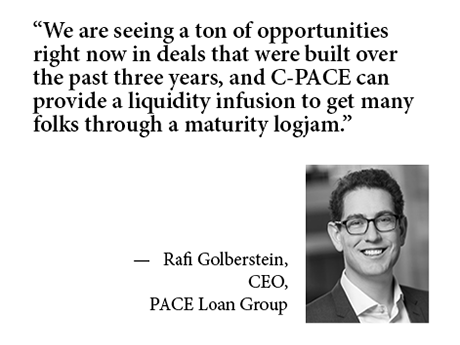The spike in interest rates and the consequent disruption throughout real estate capital markets over the last 18 months is generating newfound interest in commercial property assessed clean energy (C-PACE) financing. The program, which emerged more than a decade ago, pays for building upgrades to improve energy and water efficiency as well as seismic resilience in new construction and rehabs.
In cases where cost overruns, stabilization delays and declining values threaten the ability to refinance construction loans, developers are tapping C-PACE retroactively for a much-needed slug of so-called “rescue capital,” says Rafi Golberstein, CEO of the PACE Loan Group, a direct lender of C-PACE based in Minneapolis, Minn. Typically, developers are using the proceeds to pay down debt and fund reserves to secure loan extensions or modifications.
“We are seeing a ton of opportunities right now in deals that were built over the past three years, and C-PACE can provide a liquidity infusion to get many folks through a maturity logjam,” he declares. “When confronted with other options, they’re going to prefer C-PACE all day long.”
Cost-Effective Debt
Indeed, the cost of those other options, such as mezzanine financing or preferred equity, can be upwards of 500 basis points higher than C-PACE, which has a fixed interest rate of around 8 percent. In fact, while C-PACE’s cost hindered its competitiveness in the era of ultra-low short-term interest rates, today it’s on par with or even cheaper than conventional bridge loans.
But that’s just one reason to pursue C-PACE, notes Golberstein, whose firm closed fewer, but larger, loans in 2023 than in 2022 due to fluctuating mortgage markets. The program can finance up to 40 percent of a project’s capital stack, and unlike conventional senior loans that are secured by the mortgage, C-PACE becomes a property assessment that landlords pay with their tax bills.
Plus, C-PACE terms are typically 25 to 30 years, and the loans are transferable and cannot be called. Along with C-PACE’s fixed interest, those features provide more security than mezzanine financing and preferred equity, which are short-term solutions that can have draconian penalties. “In many cases, C-PACE has become the most affordable and viable alternative solution for troubled borrowers,” Golberstein states.
Flexible Tool
Some 30 states and Washington, D.C. have authorized the program, and in 2022, C-PACE loans totaled $1.6 billion, an increase of more than 14 percent over 2021, according to PACENation, an advocate of the financing tool.
In addition to taking advantage of the program’s retroactivity, developers are tapping C-PACE to pay down the blended costs of funds in construction projects in today’s environment of high capital costs and reticent lenders, Golberstein says. Amid the frothy property markets of 18 months ago, borrowers were largely using C-PACE to increase leverage in deals as conventional loans topped out at around 75 percent of cost, he points out.
In one recent deal that closed in 37 days, PACE Loan Group provided $11.2 million in C-PACE financing to fund the development of a new hotel at the north entrance of the Joshua Tree National Park in California. The 30-year loan was combined with a $7.5 million first mortgage, which resulted in total leverage of 58.4 percent of cost.
“I refer to C-PACE as the chameleon of real estate finance,” explains Golberstein. “C-PACE has the flexibility and ability to adapt to certain situations much more so than CMBS or other financing types.”
Acceptance Grows
C-PACE’s retroactivity has piqued the interest of mortgage brokers, who previously tended to avoid pursuing C-PACE because of its unfamiliarity. But in October, mortgage brokers initiated 65 percent of PACE Loan Group’s deal flow, compared to 35 percent a year earlier, Golberstein remarks.
“We’ve done a lot of knocking on the doors of national mortgage brokerages, and they would say things like, ‘This sounds complicated,’” he recalls. “But the market has effectively forced them to finally look at C-PACE as an important and viable part of the capital stack.”
The same discovery is taking place among mortgage lenders, who need to provide borrowers with consent to use C-PACE. Lenders with troubled loans increasingly recognize C-PACE as an avenue to liquidity, especially when used retroactively. “We have found that lender consent has become less of an uphill battle over the past year,” Golberstein adds.
Despite making headway in those areas, C-PACE lenders continue to battle barriers that are preventing wider adoption of the tool. Among the largest are eligibility misconceptions among developers, who think that they’ll need to spend more than what the scope of a construction project calls for, he reports.
“Nine-and-a-half times out of 10, projects are good to go as designed — they already include high-efficiency mechanical systems, lights and building envelopes necessary for C-PACE. Developers are already contributing to the ESG goals — this just helps them leverage that impact by getting a better financing package,” says Golberstein.
— By Joe Gose. PACE Loan Group is a content partner of REBusinessOnline. To learn more about PACE Loan Group, click here, or access their Get a Quote form here.


